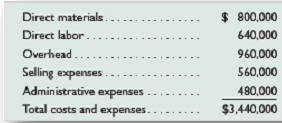1. Sales mix determination and analysis
Bethel Company owns a machine that can produce two specialized products. Production time for Product TLX is two units per hour and for Product MTV is five units per hour. The machine's capacity is 2,200 hours per year. Both products are sold to a single customer who has agreed to buy all of the company's output up to a maximum of 3,750 units of Product TLX and 2,000 units of Product MTV. Selling prices and variable costs per unit to produce the products follow. Determine (1) the company's most profitable sales mix and (2) the contribution margin that results from that sales mix.

2. Analysis of income effects of additional business
Calla Company produces skateboards that sell for $50 per unit. The company currently has the capacity to produce 90,000 skateboards per year, but is selling 80,000 skateboards per year. Annual costs for 80,000 skateboards follow.

A new retail store has offered to buy 10,000 of its skateboards for $45 per unit. The store is in a different market from Calla's regular customers and it would not affect regular sales. A study of its costs in anticipation of this additional business reveals the following:
• Direct materials and direct labor are 100% variable.
• Thirty percent of overhead is fixed at any production level from 80,000 units to 90,000 units; the remaining 70% of annual overhead costs are variable with respect to volume.
• Selling expenses are 60% variable with respect to number of units sold, and the other 40% of selling expenses are fixed.
• There will be an additional $2 per unit selling expense for this order.
• Administrative expenses would increase by a $1,000 fixed amount.
1. Prepare a three-column comparative income statement that reports the following:
a. Annual income without the special order.
b. Annual income from the special order.
c. Combined annual income from normal business and the new business.
2. Should Calla accept the order? What nonfinancial factors should Calla consider? Explain.
3. Assume that the new customer wants to buy 15,000 units instead of 10,000 units. It will only buy 15,000 units or none and will not take a partial order. Without any computations, how does this change your answer to part 2?